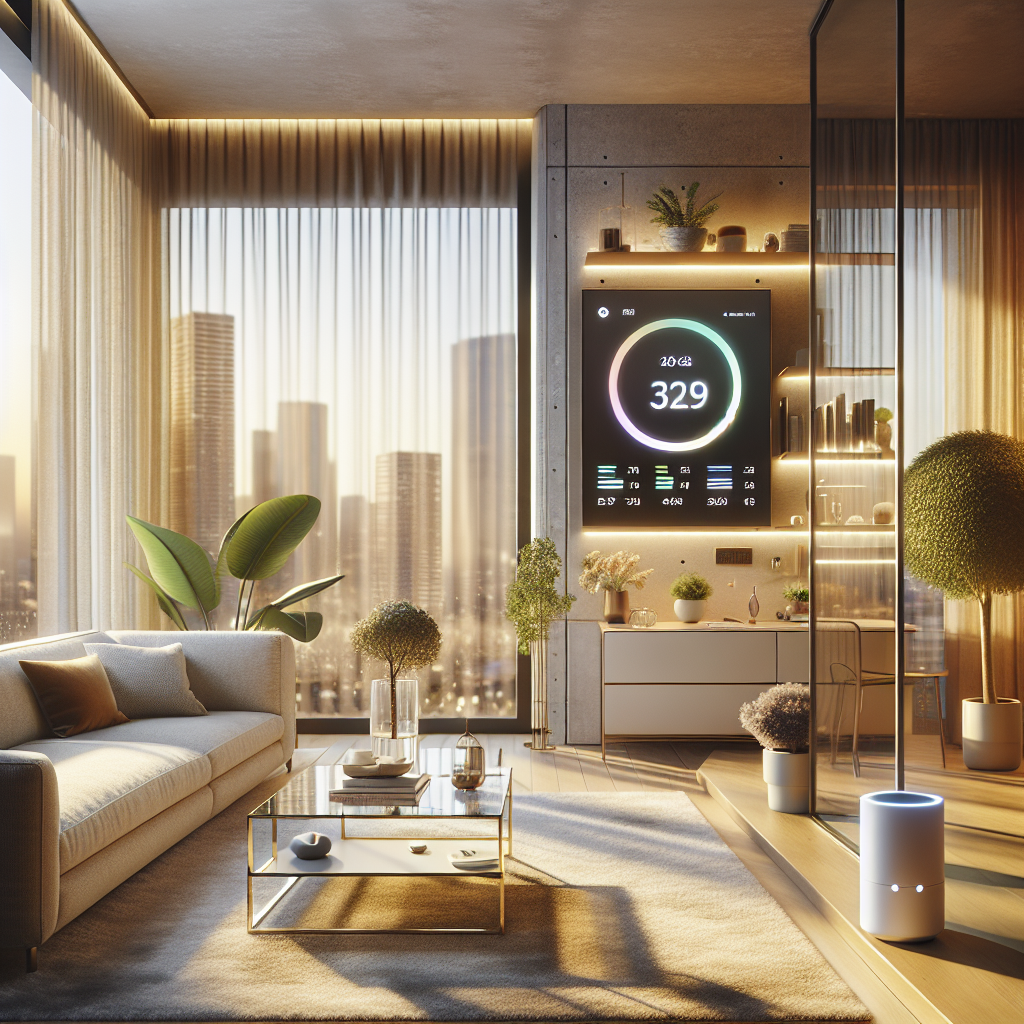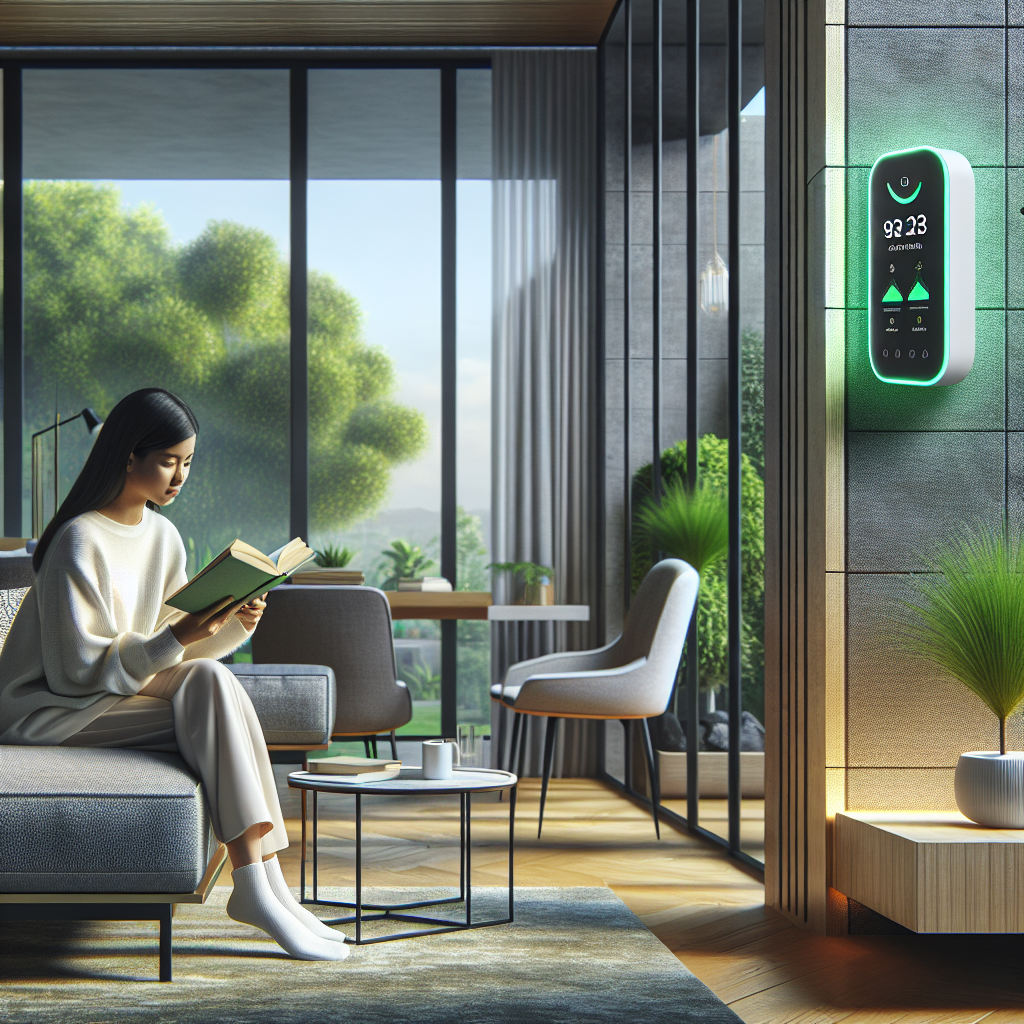In today’s fast-paced world, ensuring the air quality in our homes is more important than ever. With the advancement of technology, smart home sensors have become a game-changer in monitoring air quality. These compact devices can detect harmful pollutants, allergens, and even humidity levels, providing real-time data to help keep our living environments safe and healthy. By integrating these sensors into our homes, we can take control of our indoor air quality and make informed decisions to improve our overall well-being. Join the smart home revolution and breathe easier with smart home sensors for monitoring air quality.
Understanding Air Quality Monitoring
The Importance of Monitoring Air Quality at Home
Indoor air quality plays a crucial role in the overall health and well-being of individuals, as most people spend the majority of their time indoors. Monitoring air quality within the home environment is essential to ensure that the air occupants breathe is clean and free from harmful pollutants. By utilizing smart home sensors for air quality monitoring, residents can gain real-time insights into the levels of various pollutants present in their living spaces. This data can help individuals take proactive measures to improve indoor air quality and create a healthier living environment for themselves and their families.
Common Air Pollutants Found in Indoor Spaces
Indoor air can be contaminated by a variety of pollutants, including volatile organic compounds (VOCs), particulate matter, carbon monoxide, radon, and mold spores. VOCs are emitted from household products such as paints, cleaning agents, and furniture, contributing to poor indoor air quality. Particulate matter, such as dust, pollen, and pet dander, can also accumulate indoors and exacerbate respiratory issues. Carbon monoxide, a colorless and odorless gas, poses a significant health risk when present in high concentrations. Radon, a radioactive gas that seeps into homes through the ground, is another common indoor air pollutant that can have long-term health effects. Mold spores thrive in damp and poorly ventilated areas, leading to respiratory problems and allergic reactions in sensitive individuals.
Health Implications of Poor Air Quality
Exposure to poor indoor air quality can have serious health implications, ranging from minor irritations to severe respiratory conditions. Short-term effects of breathing in polluted air include headaches, dizziness, fatigue, and irritation of the eyes, nose, and throat. Prolonged exposure to indoor air pollutants can exacerbate existing respiratory conditions such as asthma and allergies, leading to increased symptoms and decreased quality of life. In the long term, chronic exposure to indoor air pollutants has been linked to respiratory diseases, cardiovascular issues, and even cancer. Monitoring air quality at home is crucial for safeguarding the health of occupants and mitigating the risks associated with poor indoor air quality.
Overview of Smart Home Sensors

Definition and Functionality
Smart Home Sensors are advanced devices designed to monitor and measure various aspects of indoor air quality within a home environment. These sensors are equipped with cutting-edge technology that enables them to detect and analyze different pollutants and gases present in the air, providing real-time data and insights to homeowners.
Functionality:
– Air Quality Monitoring: Smart home sensors utilize sophisticated sensors and algorithms to continuously monitor the air quality inside a home. They can detect pollutants such as volatile organic compounds (VOCs), carbon monoxide, and particulate matter.
– Data Collection: These sensors collect data on air quality parameters such as temperature, humidity, and air pressure. This data is then transmitted to a central hub or mobile application for analysis and interpretation.
– Alert Systems: Smart home sensors are programmed to send alerts or notifications to homeowners when air quality levels exceed predefined thresholds. This feature helps users take immediate action to improve indoor air quality.
– Integration with Smart Home Systems: These sensors can be integrated with other smart home devices such as air purifiers, thermostats, and HVAC systems. This integration allows for automated responses to maintain optimal air quality levels.
– Remote Monitoring: One of the key functionalities of smart home sensors is the ability to monitor air quality remotely. Users can access real-time data and insights through a smartphone app or web portal, enabling them to make informed decisions about their indoor environment.
Types of Smart Home Sensors
Particulate Matter Sensors
Particulate matter sensors are designed to detect and measure the concentration of tiny particles suspended in the air. These sensors can monitor pollutants such as dust, smoke, pollen, and other airborne particles that can have detrimental effects on respiratory health. By providing real-time data on particulate levels, these sensors enable homeowners to take proactive measures to improve indoor air quality.
Volatile Organic Compound (VOC) Sensors
Volatile organic compound sensors are essential for detecting harmful gases emitted from everyday household products such as cleaning agents, paints, and furniture. These sensors can identify a wide range of VOCs, including formaldehyde, benzene, and toluene, which can contribute to indoor air pollution and pose health risks. By alerting residents to elevated VOC levels, these sensors empower individuals to minimize exposure and enhance the overall air quality within their homes.
Carbon Monoxide Detectors
Carbon monoxide detectors are crucial for safeguarding against the silent threat of carbon monoxide poisoning. These sensors can detect the presence of this odorless and colorless gas, which is produced by combustion processes in gas furnaces, stoves, and fireplaces. By promptly signaling when carbon monoxide levels exceed safety thresholds, these detectors play a vital role in preventing potential health emergencies and ensuring a safe living environment for occupants.
Humidity Sensors
Humidity sensors are instrumental in monitoring and controlling indoor humidity levels to prevent mold growth and maintain comfort. These sensors measure the amount of moisture in the air, helping homeowners to regulate humidity levels for optimal air quality and occupant well-being. By providing insights into humidity fluctuations, these sensors enable individuals to implement appropriate ventilation and dehumidification strategies to mitigate the risk of mold infestations and maintain a healthy indoor environment.
Benefits of Using Smart Home Sensors
- Real-time Monitoring and Alerts
Smart home sensors for monitoring air quality offer the advantage of real-time monitoring, allowing homeowners to stay informed about the air quality within their living spaces. These sensors continuously track various air pollutants such as volatile organic compounds (VOCs), particulate matter, carbon monoxide, and more. By providing instant feedback on the air quality levels, users can take prompt actions to address any potential concerns and ensure a healthier indoor environment.
- Integration with Smart Home Systems
Another benefit of utilizing smart home sensors for air quality monitoring is their seamless integration with existing smart home systems. These sensors can be easily connected to smart home hubs or devices, enabling users to access air quality data through their smartphones or other smart devices. This integration enables homeowners to conveniently monitor and manage air quality levels remotely, making it easier to maintain a comfortable and healthy living environment.
- Data Analysis and Insights for Health Improvement
Smart home sensors not only monitor air quality but also collect and analyze data over time. By tracking air quality trends and fluctuations, these sensors can provide valuable insights into potential sources of indoor air pollution and help users make informed decisions to improve their health. The data generated by these sensors can also be used to identify patterns and correlations between air quality and health outcomes, offering opportunities for targeted interventions and lifestyle adjustments for better well-being.
Factors to Consider When Choosing Smart Home Sensors
When selecting smart home sensors for monitoring air quality, several crucial factors should be taken into account:
- Accuracy and Precision of Sensor Readings
It is essential to choose sensors that provide accurate and precise readings of air quality parameters such as particulate matter, volatile organic compounds, carbon dioxide, and humidity. The reliability of the sensor data directly impacts the effectiveness of air quality monitoring and subsequent actions to improve indoor air quality.
- Connectivity and Compatibility with Smart Home Platforms
Smart home sensors should seamlessly integrate with existing smart home platforms to enable real-time monitoring and remote access to air quality data. Compatibility with popular platforms such as Google Home, Amazon Alexa, or Apple HomeKit ensures ease of use and access to air quality information from various devices.
- Cost and Maintenance Requirements
Consider the initial cost of purchasing smart home sensors, as well as any ongoing maintenance expenses such as calibration or sensor replacement. Opt for sensors that offer long-term reliability and require minimal upkeep to ensure continuous and accurate air quality monitoring in the home.

Installation and Placement Tips for Smart Home Sensors
Proper installation and strategic placement of smart home sensors play a crucial role in effectively monitoring air quality within a living space. Consider the following tips for optimal performance:
-
Ideal Locations for Different Types of Sensors
When installing smart home sensors for air quality monitoring, it is essential to place specific types of sensors in appropriate locations to ensure accurate readings. For instance, carbon monoxide detectors should be positioned near potential sources of combustion, such as gas stoves or fireplaces. In contrast, particulate matter sensors should be placed in areas with high traffic or close to sources of indoor air pollution, like smoking areas or cooking spaces. Understanding the unique requirements of each sensor can help in determining the most suitable locations for installation.
-
Avoiding Interference and Obstructions
To prevent interference with sensor readings, it is crucial to avoid placing sensors in areas that may be affected by external factors. Avoid positioning sensors near air vents, windows, or doors where airflow patterns could impact the accuracy of measurements. Additionally, keep sensors away from electronic devices or appliances that emit electromagnetic signals, as these can interfere with sensor performance. Ensuring a clear and unobstructed path for air circulation around the sensors can help maintain consistent and reliable data.
-
Regular Calibration and Maintenance Practices

Regular calibration and maintenance of smart home sensors are essential to ensure their continued accuracy and effectiveness in monitoring air quality. Follow the manufacturer’s guidelines for calibration procedures and schedule routine maintenance checks to detect any issues promptly. Keep sensors clean and free of dust or debris that could obstruct sensors or affect readings. By incorporating regular calibration and maintenance practices into your sensor setup, you can enhance the overall performance and reliability of your smart home air quality monitoring system.
Future Trends in Smart Home Air Quality Monitoring
Advances in Sensor Technology
-
Miniaturization: One of the key trends in smart home air quality monitoring is the miniaturization of sensors. Smaller sensors allow for more discreet placement throughout the home, providing comprehensive coverage without being obtrusive.
-
Multi-functionality: Another trend is the development of sensors with multiple functions. These sensors can monitor not only air quality but also temperature, humidity, and even detect pollutants such as carbon monoxide and volatile organic compounds.
-
Wireless Connectivity: Advanced sensors now come equipped with wireless connectivity, enabling them to seamlessly integrate with smart home systems. This allows for real-time monitoring and remote access to air quality data.
Integration with Artificial Intelligence for Predictive Analysis
-
Data Analytics: The integration of smart home sensors with artificial intelligence algorithms enables predictive analysis of air quality trends. By analyzing historical data and environmental factors, AI can anticipate changes in air quality and provide timely alerts or recommendations to improve indoor air quality.
-
Automation: AI-powered smart home systems can automate responses to poor air quality, such as adjusting ventilation systems, activating air purifiers, or even alerting occupants to open windows for better ventilation.
Potential for Smart Home Sensors to Improve Overall Well-being
-
Health Monitoring: Smart home sensors not only monitor air quality but can also contribute to overall well-being by detecting allergens, pollutants, and other harmful substances that may impact health. This proactive approach can help prevent respiratory issues and other health problems associated with poor indoor air quality.
-
Personalization: By continuously monitoring air quality and analyzing occupant behavior, smart home systems can personalize recommendations for improving indoor air quality. This tailored approach ensures that occupants receive specific actions to optimize their living environment based on their habits and preferences.
FAQs: Smart Home Sensors for Monitoring Air Quality
What are smart home sensors for monitoring air quality?
Smart home sensors for monitoring air quality are devices that can detect and measure various pollutants and particles in the air in your home. These sensors can provide real-time data on the air quality levels, including information on dust, smoke, VOCs, temperature, humidity, and more.
How do smart home sensors for monitoring air quality work?
Smart home sensors for monitoring air quality typically use a combination of sensors to detect different pollutants in the air. These sensors can measure the levels of particulate matter, volatile organic compounds (VOCs), carbon dioxide, temperature, and humidity. The data collected by the sensors is then transmitted to a central hub or mobile app for easy monitoring and analysis.
Why is monitoring air quality in your home important?
Monitoring air quality in your home is important because poor indoor air quality can lead to various health problems, including respiratory issues, allergies, and even more serious conditions over time. By using smart home sensors to monitor air quality, you can identify and address potential sources of pollutants and improve the overall quality of the air you breathe in your home.
How can smart home sensors for monitoring air quality benefit homeowners?
Smart home sensors for monitoring air quality can benefit homeowners in several ways. These sensors can provide real-time data on air quality levels, allowing homeowners to make informed decisions about their indoor environment. By monitoring air quality, homeowners can also reduce their exposure to pollutants, improve indoor air quality, and create a healthier living environment for themselves and their families.
Are smart home sensors for monitoring air quality easy to install and use?
Yes, smart home sensors for monitoring air quality are typically easy to install and use. Most sensors can be easily set up and connected to a central hub or mobile app within minutes. Once installed, the sensors can provide real-time data on air quality levels and send alerts or notifications when levels are outside of the desired range.